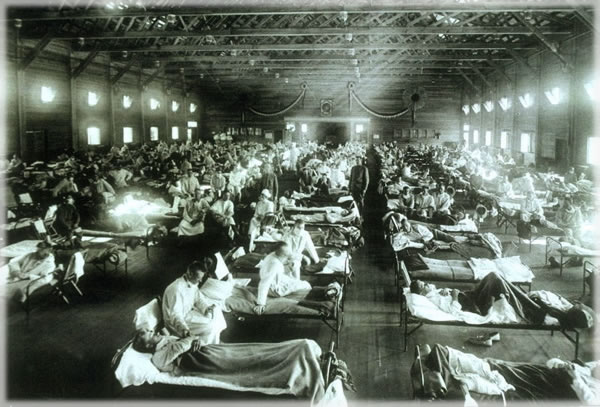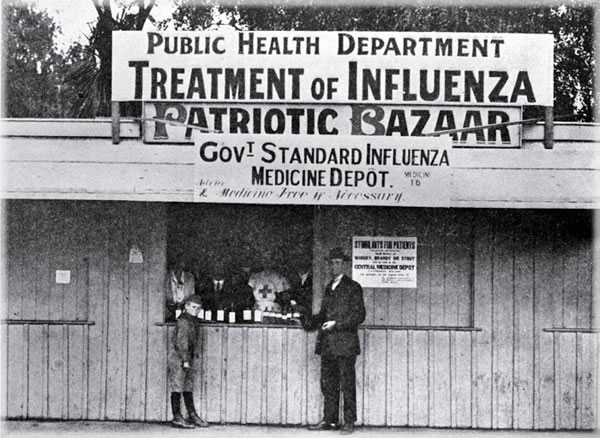 Emergency hospital during 1918 influenza epidemic, Camp Funston, Kansas. Conventional doctors had little power to help patients who suffered from Spanish Flu and nearly a third of their patients died. Source: National Museum of Health and Medicine, Armed Forces Institute of Pathology, Washington, D.C., via FluWikie.com. By
Eric Francis
IF YOU WANT to know why public health officials are so concerned about the possibility of an Avian Influenza outbreak, just learn a little about the 1918-1919 worldwide flu pandemic, called the Spanish Flu. But as you do, notice your fear level and your other responses. By one estimate, 5 percent of the world population was lost to this disease, which had the power to kill people from within six hours of the first onset of symptoms. Nearly one in five people suffered from the disease worldwide to some extent, according to Wikipedia (link below). In the United States, some 28 percent of the population suffered from Spanish Flu, and more than 500,000 died from it. There were reports of people falling off their horses dead, or dying walking down the street. And it was a disease over which the traditional medical profession had no power whatsoever. But homeopathy, a branch of medicine founded by Samuel Hahnemann in the late 18th century, had close to complete success dealing with this disease. Homeopathy is uniquely suited to handle large outbreaks of virulent diseases in the population, both preventively, and on a wide scale once an outbreak has occurred. Controversial Medicine What is not commonly known is how effective homeopathic medicine was at dealing with Spanish Flu, nor the business interests that keep the information hidden from the public. The same is true today as it was in 1918-1919. Despite being around for more than a century at the time of the Spanish Flu, homeopathy was considered a new school of thought -- new, but based on ideas going back to Hippocrates ("like cures like"). And it had been under sharp attack by something called the American Medical Association (AMA), which had been founded about 75 years earlier specifically to deal with the business threat presented to conventional doctors by homeopaths. To the current day, conventional doctors will tell you that homeopathy is a sham, based on the fact that under the usual definition of science, its methods do not add up. But I assure you that no person making such a claim is homeopathically trained. It's interesting to note that through the 1960s, 70s and 80s, the AMA went to war with chiropractors in much the same way that it unsuccessfully attempted to destroy homeopathy. Chiropractic, invented in 1895 by Dr. D.D. Palmer, was considered a business threat to medicine and treated as such. It was subjected to a vicious, decades-long smear campaign that was waged by people whose later court testimony demonstrated did not even understand the art. Then a brave, persistent chiropractor in Chicago named Dr. Chester Wilk brought a federal lawsuit against the AMA and many other organizations in the 1980s, alleging conspiracy and unfair trade practices. He fought his suit through many perils for more than a decade, finally proving that the scam existed, and getting both an apology and substantial cash settlements from traditional doctors. Business interests continue to dominate the medical field and bias the discussion of what is possible, and how you get it done. Note carefully that George Bush's spontaneously announced plan for dealing with an influenza outbreak in November consisted largely of giving billions to the pharmaceutical industry. Note also that Secretary of Defense Donald Rumsfeld was the chairman of Gilead Sciences, the California biotech company that owns the rights to Tamiflu, the influenza remedy "that's now the most-sought after drug in the world," in the apt words of Fortune magazine. Rumsfeld's stock portfolio should be doing very well right now. Besides the conflict of interest, the problem is that Tamiflu is not proven to work against the strain of Avian Influenza that is now decimating bird populations, H5N1. If there is a pandemic, we don't know the strain that will cause it; thus we have no way of knowing if it will respond. In addition, the drug must be delivered quickly where it is needed; the instructions say it must be administered within 48 hours of known exposure or onset of symptoms. But with the right help, there is a very good chance that even the worst flu pandemic is both preventable in communities, and treatable in those who come down with it. The success of homeopathy in the Spanish Flu pandemic has been studied statistically. But I have not seen or heard homeopathy mentioned once in all the reporting on H5N1 for the past year.  Medicine depot in Cathedral Square, in the city of Christchurch, New Zealand, where the Government standard influenza medicine was supplied. This was truly a worldwide pandemic, reaching every corner of the globe. Image courtesy of Christchurch City Libraries. Effectiveness of Homeopathy Shortly after the 1918-1919 pandemic, a doctor named Dean W. A. Pearson of Philadelphia collected 26,975 cases of Spanish Flu treated by homeopaths, and determined that the mortality rate was 1.05%, "while the average old school mortality is 30%." Ships returning from World War I were often called "floating caskets," where so many men were sick and dying that body fluids were running through the corridors. Yet on two ships returning from Europe whose regiments were fortunate enough to have homeopaths as the physician, there were no outbreaks, just isolated cases. The remedy used was Gelsemium simpervirens, which is cheap and easily available. There were other studies that indicated similar success rates for homeopathy. You can read about them here, in an article by Julian Winston. Every disease has individual properties, and every case has even more specific qualities, and that is what homeopathy studies in finding the right remedy. In the case of a mass outbreak, it is possible to study the properties of the disease in a population and prescribe a remedy that will work for most people, or nearly everyone. Gelsemium may or may not be the right remedy for whatever form of Avian Influenza that may propagate -- if it does -- but once more is known about the symptom pattern, homeopaths will figure it out. Remedies have both psychological and physical properties. These properties overlap, and both are involved in the disease and healing processes. Perhaps the most interesting quality of the remedy Gelsemium is that the main psychological property is fear, in particular, anticipation anxiety. And this is the remedy that was used to treat Spanish Flu. Equally interesting is that when you take flu virus and make it into a remedy (called Influenznum ), you create a substance with a psychological property of fear, and which can treat both fear and flu. So influenza is closely associated with fear, and that emotion is a very serious problem on the planet right now. Avian Influenza is itself being used as a fear-inducing tactic and distraction from other problems, and all in all, in homeopathic terms, the ground is pretty fertile for a pandemic. But at least homeopathy understands the problem. Finding the Right Remedy It will not be possible to find the right remedy for a pandemic until it actually happens. Each pandemic has unique properties that must be studied. Hahnemann, in his book of medical theory called The Organon, a set of guidelines for homeopathic diagnosis and prescription, said that "the strange, rare and particular should be foremost in the physician's mind" -- and that these unique properties are what give the clues to the right remedy. Homeopathy has more than 5,000 choices of remedies to work with, all of which are available at low cost today, and which can be manufactured quickly because the process for making the remedies is relatively simple and known in every country. Most methods of making remedies are not patented. The reason homeopaths don't know how to treat the disease today is that there have been very few human cases of H5N1, and since this strain apparently does not spread from human to human, the actual strain that would cause a pandemic is not known, and will have different properties. Therefore, its specific symptoms are not known at this time, such as how it progresses, the specific kinds of pain involved, the mental state of the patients, and many other factors -- and these are what homeopathy needs to make its prescription. Once known, this information can be distributed worldwide and used anywhere, if necessary. Such was true during the outbreak of cholera in Europe in the 1830s, during Hahnemann's lifetime. He did not ever see a single case, but was able to prescribe a remedy that was effective at both curing and preventing the disease in Europe -- where his prescription was known for and used widely with success. However, according to Peter Gold of the National Institute for Homeopathy, the most likely remedy to work as a preventive until the specific remedy is known is called Influenzinum, which is a highly diluted form of the common flu -- a little like a homeopathic vaccination, but it's not poisonous. Homeopathy dilutes its remedies hundreds or thousands of times to eliminate the physical properties of the substance and keep only the energetic ones. It's a little like giving your aura a vaccine while leaving your body alone. Influenzinum, he said, could be used as a preventive in the event of an outbreak in one's community, until the more specific remedy information becomes available. And you can keep an abundant supply on hand for about $20 or less. If you order, you will be asked what potency you want. It's best to keep a variety of potencies on hand; two tubes each of 30CH, 200K and 1M will suffice. If and when the time comes, use the correct potency as recommended by a homeopath. These remedies will be available without a prescription. In the United States, many health food stores can get remedies, but often not above the 30CH potency. For that, it's necessary to go to a lab or special pharmacy (see below). On this note, however, I highly suggest you look up the names of homeopathic practitioners in your area and get acquainted with one or two of them. If you can afford a consultation, it's a good idea to have one -- this way they know you personally and have a file on you. Homeopathic consultations, which are like a 45 minute interview, are usually fairly inexpensive compared to a five minute doctor visit. Homeopathic remedies are available in any pharmacy in France, at Nelson's Pharmacy in London, and in the United States from Hahnemann Labs in San Rafael (by phone or Internet order). There will be much frightening news about Avian Influenza in the next 12 months. But rest easy, because homeopathy can help. Resources National Institute for Homeopathy Homeopathic Educational Services Nelson Pharmacy, London Hahnemann Labs of San Rafael, CA Wikipedia on Homeopaty Wikipedia on Spanish Flu |
For customer service, please call (877) 453-8265, or + (206) 567-4455.